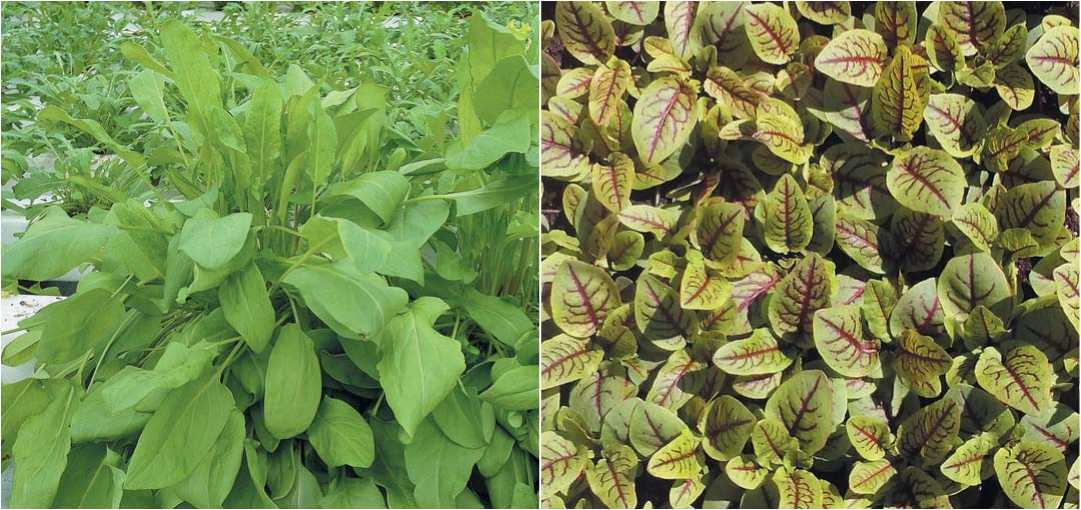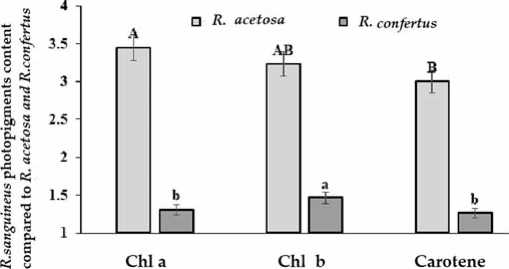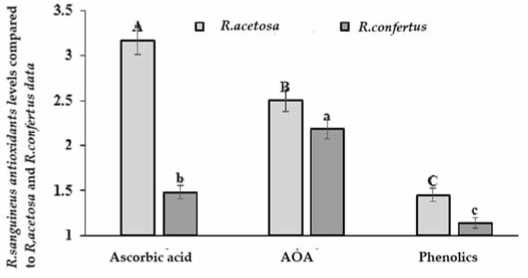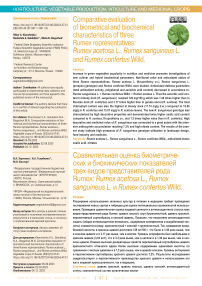Comparative evaluation of biometrical and biochemical characteristics of three Rumex representatives: Rumex acetosa L., Rumex sanguineus L. and Rumex confertus Willd
Автор: Kharchenko V.A., Golubkina N.A., Bogachuk M.N.
Журнал: Овощи России @vegetables
Рубрика: Садоводство, овощеводство, виноградарство и лекарственные культуры
Статья в выпуске: 6 (74), 2023 года.
Бесплатный доступ
Increase in green vegetables popularity in nutrition and medicine promotes investigations of new cultivar and hybrid biochemical parameters. Nutritional value and antioxidant status of three Rumex representatives: Rumex acetosa L. (Krupnolistny cv.), Rumex sanguineus L. (prospect genotype) and Rumex confertus Willd. were studied. Antioxidant defense parameters (total antioxidant activity, polyphenol and ascorbic acid content) decreased in accordance to: Rumex sanguineus L. > Rumes confertus Willd. > Rumex acetosa L. Thus the ascorbic acid content in bloody dock (R. sanguineus) reached 129 mg/100 g which was 1.48 times higher than in Russian dock (R. confertus) and 3.17 times higher than in garden sorrel (R. acetosa). The total chlorophyll content was also the highest in bloody dock (17.74 mg/g d.w.) compared to 15.88 mg/g in R. confertus and 13.07 mg/g in R. acetosa leaves. The new R. sanguineus genotype was characterized by high decorative properties and demonstrated twice higher oxalic acid content compared to R. acetosa, Krupnolistny cv., and 1.5 times higher value than in R. confertus. High decorative and medicinal value of R. sanguineus was connected to a great extent with the intensive anthocyanin accumulation reaching 7.2% and high nitrate content. The results of the present study indicate high prospects of R. sanguineus genotype utilization in landscape design, food industry and medicine.
Rumex acetosa l, rumex sanguineus l, rumex confertus willd, antioxidant status oxalic acid, nitrates
Короткий адрес: https://sciup.org/140303347
IDR: 140303347 | УДК: 635.45:(57.087.1+581.19) | DOI: 10.18619/2072-9146-2023-6-47-51
Текст научной статьи Comparative evaluation of biometrical and biochemical characteristics of three Rumex representatives: Rumex acetosa L., Rumex sanguineus L. and Rumex confertus Willd
Оригинальная статья / Original article УДК 635.45:(57.087.1+581.19)
H ardy perennial plants of Rumex genus belonging to Polygonaceae family compose about 200 species widely distributed in most countries of the world [1] and are highly valued in medicine [2-4]. About 70 Rumex species are found at the territory of Russia. The sorrels are characterized by intensive growth, high adaptability and high antioxidant content, polyphenols in particular [5]. These facts indicate that Rumex representatives belong to a group of cosmopolite plants. Separate species are used as vegetables and medicinal species.
Roots of many species are rich in tannins. Sorrel has long been used in traditional medicine for skin [2] and oncological diseases [6] treatment. Leaf extract records antiviral properties and is efficient in herpes treatment [7].
Bloody dock ( Rumex sanguineus ) is widely used in treatment of blood circulatory system and severe bleeding, as a powerful antiseptic, astringent and cardio tonic drug [8].
All Rumex species studied demonstrate antibacterial, anticancer, anti-inflammatory, antioxidant and cardio protective properties.
The most important biologically active compounds of Rumex are flavonoids, anthraquinones, alkaloids, terpenes, lignans and tannins [3,8].
Monitoring of Rumex wild representatives revealed important natural sources of flavonoids ( R. maritimus ), tannins ( R. obtusifolius ), catechins ( R. sanguineus ), proanthocyanidins ( R. sanguineus, R. obtusifolius, R. crispus ) and hydroxycinnamic acids ( R. аcetosella ) [4,5].
High biological activity and nutritional value of many sorrel species indicate the importance of sorrel breeding aimed to obtain high yield and products with enhanced content of biologically active compounds. At present the most popular sorrel cultivars in Russia are Belvilsky, Krupnolistny, Malakhit, Odessky 17, Shirokolostny, Shpinatny. As an ornamental plants several bloody dock cultivars are produced: Krasnye zhilky, Krasnye uzory, Krovavaya Mery, Sanguinic and Gamma. In should be noted that most of breeding investigations are achieved on garden sorrel ( R. acetosa ) widely used in nutrition. The present investigation is devoted to the comparative evaluation of biochemical parameters of the new R. sanguineus genotype, garden sorrel ( R. acetosa ), Krupnolistny cv., and Russian sorrel ( R. confertus ) to reveal prospects of the new genotype utilization in food industry and medicine.
Material and Methods
The objects of the present investigation were a new R. sanguineus genotype, garden sorrel, Krupnolistny cv. (selection of Federal Scientific Vegetable Center), and Russian (wild) sorrel. Plants were grown on experimental fields of Federal Scientific Vegetable Center, Moscow region in 2022-2023 (55◦39.510 N, 37◦12.230 E) in a loam sod podzolic soil with the following characteristics: pH 6.2, 2.12% organic matter, 1.32 mg-eq 100 g-1 hydrolytic acidity, 18.5 mg kg-1 mineral nitrogen, 21.3 mg kg-1 ammonium nitrogen, sum of absorbed bases as much as 93.6%, 402 mg kg-1 mobile phosphorous, 198 mg kg-1 exchangeable potassium, 1 mg kg-1 S, 10.95 mg kg-1 Ca, 2.05 mg kg-1Zn, 0.86 mg kg-1 B, 220 µg kg-1 d.w. Se, 7.65 mg kg-1 Ni, 0.22 mg kg-1 Cd, 1.6 mg kg-1 As, 12.85 mg kg-1 Pb.
Seeds sowing was achieved on April, 25, 5 cm apart and 10 cm between rows. Plants harvesting was practiced on
August,15. Ten plants from each species were gathered for the investigation. Samples of Russian sorrel ( R. confertus ) were gathered near the experimental fields of the Institute.
Leaves were washed with water to remove traces of soil particles, dried at filter paper and weighed. Homogenized fresh leaves were used for the determinations of photosynthetic pigments, nitrates and ascorbic acid. The remaining part of samples were dried at 70оС to constant weight, homogenized and the resulting powder was used fort the determination of oxalic acid, polyphenol content, and total antioxidant (AOA) activity.
Dry Matter
The dry matter was assessed gravimetrically by drying the samples in an oven at 70°C until constant weight according to [9].
Nitrates
Nitrates were assessed using ion-selective electrode with ionomer Expert-001 (Econix Inc., Moscow, Russia).
Ascorbic Acid
The ascorbic acid content was determined by visual titration of leaf extracts in 3% trichloracetic acid with sodium 2.6-dichlorophenol indophenolate solution (Tillman’s reagent) [10].
Photosynthetic Pigments
Photosynthetic pigments of sorrel leaves were measured spectrophotometrically using 96% ethanolic extracts [13]. Chlorophyll and carotene content was calculated according to the following equations:
Ch-a = 13.36A 664 –5.19A 649 ;
Ch-b = 27.43A 649 –8.12A 664 ;
C c = (1000A 470 –2.13Ch-a–97.63C-b)/209
where A = light absorption, Ch-a = chlorophyll a, Ch-b = chlorophyll b, C c = carotene
The results were expressed in mg/g dry weight.
Total Polyphenols (TP)
Total polyphenols were determined in 70% ethanol extracts of dried samples using the Folin–Ciocalteu colorimetric method as previously described [11]. Half a gram of dry homogenates was extracted with 20 mL of 70% ethanol/water at 80◦C for 1 h. The mixture was cooled down and quantitatively transferred to a volumetric flask, and the volume was adjusted to 25 mL. The mixture was filtered through filter paper, and 1 mL of the resulting solution was transferred to a 25 mL volumetric flask, to which 2.5 mL of saturated Na 2 CO 3 solution and 0.25 mL of diluted (1:1) Folin–Ciocalteu reagent were added. The volume of a mixture was brought to 25 mL with distilled water. One hour later the solutions were analyzed through a spectrophotometer (Unico 2804 UV, Suite E Dayton, NJ, USA), and the concentration of polyphenols was calculated according to the absorption of the reaction mixture at 730 nm. As an external standard, 0.02% gallic acid was used. The results were expressed as mg of gallic acid equivalent per g of dry weight (mg GAE g-1 d.w).
Antioxidant Activity (AOA)
The antioxidant activity of sorrel leaves was assessed on a 70 % ethanolic extracts of dry samples using a redox titra- tion method [11]. The values were expressed in mg gallic acid equivalents (mg GAE g-1 d.w.)
Anthocyanins
Anthocyanin content was determined via differential spectrophotometry on spectrophotometer Unico 2804 UV using light absorption of methanolic extracts at 520 nm and pH 3.5 and 1.0 [12]. Anthocyanin content (in mg-eq cyanid-ing-3-glucosyde) was calculated according to the formula
Ac = (∆D × 449 × V × 1000)/(26,900 × a), where ∆D – differences in the extract light absorption at 520 nm in conditions of different pH (1.0 and рН 3.5). The value of ‘449’ refers to molecular mass of cyaniding-3-gluco-side, V – extract volume, ml, 1000 – coefficient to transfer the values per 100 ml of the extract, 26.900 –cyaniding-3-glucoside extinction, а- sample weight, g.
Oxalic acid
Oxalic acid content was determines via HPLC (Agilent 1100): column Zorbax Bonus-RP C18, 4.6 Х 250 мМ, 5µM; flow rate – 1.0 mL/min; wave length – 210 nm. Mobile phase – isoctratic elution with phosphate buffer, pH 2.5 [14].
Statistical Analysis
Data were processed by analysis of variance, and mean separations were performed through the Duncan’s multiple range test, with reference to 0.05 probability level, using SPSS software version 21 (Armonk, NY, USA).
Results and Discussion
Figure 1 represents high ornamental properties of R. sunguineus new genotype with typical distinct red leaf veins and significantly smaller leaf size compared to Krupnolistny cultivar of garden sorrel R. acetosa (Figure 1; Table 1).
Indeed, leaf area of R. Sunguineus new genotype was 2.6 times smaller than the appropriate parameter of garden sorrel, Krupnolistny cv., and 7 times smaller than leaf area of R. confertus .
The promising genotype of R. sanguineus accumulated close to R. acetosa amount of nitrates, though exceeding in the dry matter and oxalic acid content by 1.5 and 2 times accordingly. It should be noted that the detected oxalic acid concentration in bloody dock were twice higher than the described value while the appropriate differences for
|
Table 1. Yield, biometrical parameters, dry matter, nitrate and oxalic acid content in R. sanguineus, R. acetosa and R. confertus plants Таблица 1. Урожай, биометрические показатели, содержание сухого вещества, нитратов и щавелевой кислоты в R. sanguineus, R. acetosa и R. confertus |
|||
|
Parameter |
Rumex sanguineus L. |
Rumex acetosa L. Rumex confertus WILLD. |
|
|
Leaf weight, g/plant |
19.7±1.2 b |
14.9±1.1 c |
99.4±9.0 а |
|
Plant height, cm |
21±2 c |
30±3 b |
50±5a |
|
Leaf length, cm |
11.5±1.0 b |
13.0±1.1 b |
26.0±2.3 a |
|
Leaf width, cm |
4.0±0.4 c |
8.5±0.8 b |
12±1.1 a |
|
Stem length, cm |
12.0±1.0 c |
16.0±1.5 b |
23.0±2.0 a |
|
Stem width, mm |
2 b |
5 a |
5 a |
|
Leaf area, cm2 |
35.7±3.5 c |
94.4±9.1 b |
255.0±20.2 a |
|
Dry matter, % |
18.1±1.0 a |
6.9±1.0 c |
13.3±1.0 b |
|
Nitrates, mg/kg d.w. |
3392±310 a |
3333±310 a |
2398±230 b |
|
Oxalic acid, mg/g d.w. |
76.9±6.5 a |
38.6±3.1 c |
51.8±4.8 b |
|
Values in lines with similar letters do not differ statistically according to Duncan test at p<0.05 |
|||

Fig. 1.Garden sorrel,Krupnolistnycv. (1) and a new genotype ofbloody dock (2)
Рис. 1. Садовый щавель сорт Крупнолистный, перспективный краснолистный сортообразец
ISSN 2618-7132 (Online) Овощи России №6 2023 [ 49 ] Vegetable crops of Russia №6 2023 ISSN 2072-9146 (Print)
garden sorrel reached 3 times. Oxalic acid accumulation level by plants depends on many factors, such as soil character, climate, genetic peculiarities and stage of plant development [17]. Nevertheless, the present results happened to be close to those described by Tuazon-Nartea and Savage [18] and indicate the existence of significant risks of bloody dock high consumption due to the possibility of Ca bio accessibility decrease, calcium oxalate precipitation in kidney and osteoporosis development [19].
Furthermore, evaluation of biochemical characteristics indicates that R. sanguineus records the highest levels of nitrates among three species investigated. The above facts indicate the importance of similar vegetation conditions in comparative evaluation of different sorrel species and cultivars.
Photosynthetic pigments
Evaluation of photosynthetic pigments accumulation in leaves of three Rumex species recorded the lowest values typical for R. acetosa . On the contrary, these parameters did not differ statistically between R. sanguineus and R. confertus (Figure 2). It seems obvious that high chlorophyll content in leaves of bloody dock provides additional ornamental attractiveness to the new R. sanguineus genotype.
Antioxidants
Table 3 data confirm the unique antioxidant properties of a new prospect R. sanguineus genotype. Ascorbic acid concentration in leaves of this plant exceeded thrice the R. acetosa values and was 1.5 time higher than the appropriate values found for R. confertus leaves (Figure 3).
Table 2. Chlorophyll and carotene levels in sorrel leaves.
Таблица 2. Содержание хлорофилла и каротина в листьях щавеля
|
Parameter, mg/g dry weight |
Rumex sanguineus |
Rumex acetosa |
Rumex confertus |
|
Chlorophyll a |
10.50 a |
8.00 b |
10.9 a |
|
Chlorophyll b |
6.24 a |
5.07 b |
5.79 ab |
|
Total chlorophyll |
17.74 a |
13.07 b |
15.88 a |
|
Carotene |
1.82 a |
1.59 b |
1.95 a |
|
Chl а/Chl b |
1.68 |
1.57 |
1.88 |
|
Chl/carotene |
9.18 |
8.00 |
8.54 |
Values in lines with similar letters do not differ statistically according to Duncan test at p<0.05


-
Fig. 2. Differences in photosynthetic pigments accumulation by R. sanguineus compared to R. acetosa and R. confertus. Values with similar letters do not differ statisticallyaccording to Duncan testatp<0.05
Рис. 2. Различия в уровнях аккумулирования фотосинтетических пигментов краснолистным сортообразцом щавеля R. sanguineus по сравнению с садовым R. acetosa и конским щавелем R. confertus. Значения с одинаковыми индексами статистически не различаются согласно тесту Дункана при p<0.05
-
Fig. 3. Differences in antioxidantaccumulation by R. sanguineus compared to R. acetosa and R. confertus. Values with similar letters do notdiffer statistically according to Duncan test atp<0.05
Рис. 3. Различия в аккумулировании антиоксидантов краснолистным сортообразцом щавеля R. sanguineus по сравнению с садовым R. acetosa и конским щавелем R. confertus. Значения с одинаковыми индексами статистически не различаются согласно тесту Дункана при p<0.05
Table 3. Antioxidant status of R. sanguineus, R. acetosa and R. confertus Таблица 3. Антиоксидантный статус R. sanguineus, R. acetosa и R. confertus
|
Parameter |
Rumex sanguineus L. |
Rumex acetosa L. |
Rumex confertus WILLD. |
|
Ascorbic acid, mg/100 g f.w. |
129±10 a |
40.7±4.0 c |
86.9±7.9 b |
|
Anthocyanins, % |
7.2±0.6 |
следы |
следы- |
|
Antioxidant activity, mg GAE/g d.w. |
96.6±9.0 а |
38.6±3.1 b |
44.4±4.0 b |
|
Polyphenols, mg GAE/g d.w. |
28.2±2.1 a |
19.5 ±1.2 b |
24.7±2.0 a |
Values in lines with similar letters do not differ statistically according to Duncan test at p<0.05
Total antioxidant activity and polyphenol content were also amazingly higher in R. sanguineus plants than the appropriate values registered in R. confertus and R. acetosa. R. sanguineus species is known to accumulate predominantly catechins [5] while red color of their leaves is connected with high anthocyanin content. Indeed, the anthocyanin content in a new R. sanguineus genotype reached 7.2% (Table 3). The significance of high anthocyanin levels in edible plants is directly connected with the well-known antioxidant, anti-cancer, anti-inflammatory and anti-microbial properties providing high opportunities in prevention of such diseases as diabetes, cancer and obesity [20].
Besides, the new genotype of R. sanguineus was also characterized by anomalously high antioxidant levels exceeding that of R. acetosa and R. confertus by 2.5 and 2.2 time accordingly (Figure 3). This phenomenon fully miti- gates ecological risks of high nitrate levels in R. sanguineus leaves. Indeed, high nitrate consumption leading to the formation of carcinogenic nitrosamines is dangerous only in cases of low antioxidant consumption [17]. Vegetable nitrates in human diet under high consumption of vitamin C and polyphenols are considered not only safe but even beneficial for heart protection [21]. In this respect, cardio tonic effect of R. sanguineus [8] is directly connected both with high antioxidant activity and high nitrate levels.
Conclusion
Evaluation of biometrical and biochemical parameters of three Remix representatives indicated the highest antioxidant status of a new R. sanguineus genotype compared to R. acetosa and R. confertus and proved high prospects of its utilization as an ornamental plant, in human nutrition and in medicine as a powerful source of natural antioxidants.
Об авторах:
Виктор Александрович Харченко – кандидат с.-х. наук, зав. лабораторией селекции и семеноводства зеленных, пряно-вкусовых и цветочных культур, , Надежда Александровна Голубкина – доктор с.-х. наук, главный научный сотрудник лабораторно-аналитического отдела, автор для переписки, ,
Aboutthe Authors:
Viktor A. Kharchenko – Cand. Sci. (Agriculture),
Head of Laboratory of Selection and Seed Production of Green, SpiceFlavoring and Flower Crops, ,
Nadezhda A.Golubkina – Doc. Sci. (Agriculture),
Head Researcher of laboratory-analytical department, Correspondence Author, ,
Maria N.Bogachuk – Cand. Sci. (Pharmaceutic.),
Researcher at the Laboratory of Food Chemistry, ,
Список литературы Comparative evaluation of biometrical and biochemical characteristics of three Rumex representatives: Rumex acetosa L., Rumex sanguineus L. and Rumex confertus Willd
- Yu X.Y., Tan X.H., Cai W. Survey on Polygonaceae Herb Resources of in Zhejiang Tiantong National Forest Park. Medicinal Plants. 2011;2(3):22-24.
- Bensky D., Gamble A. An Encyclopedia of Traditional Chinese Medicinal Substances (Zhong Yao Da Ci Dian),” Eastland Press, Seattle, 1986.
- Bello O.M., Fasinu P.S., Bello O.E., Ogbesejana A.B., Adetunji C.O., Dada A.O., Ibitoye O.S., Aloko S., Oguntoye O.S. Wild vegetable Rumex acetosa Linn.: Its ethnobotany, pharmacology and phytochemistry – A review. South Afr. J. Bot. 2019;(125):149-160. https://doi.org/10.1016/j.sajb.2019.04.018.
- Korpelainen H., Pietiläinen M. Sorrel (Rumex acetosa L.): Not Only a Weed but a Promising Vegetable and Medicinal Plant. Bot. Rev. 2020;(86):234–246. https://doi.org/10.1007/s12229-020-09225-z.
- Feduraev P., Skrypnik L., Nebreeva S., Dzhobadze G., Vatagina A., Kalinina E., Pungin A., Maslennikov P., Riabova A., Krol O. Variability of Phenolic Compound Accumulation and Antioxidant Activity in Wild Plants of Some Rumex Species (Polygonaceae). Antioxidants. 2022;(11):311.
- Kuceková Z., Mlček J., Humpolíček P., Rop O., Valasek P., Saha P. Phenolic Compounds from Allium schoenoprasum, Tragopogon pratensis and Rumex acetosa and their Antiproliferative Effects. Molecules. 2011;16 (11):9207-9217. doi:10.3390/molecules16119207.
- Gescher K., Hensel A., Hafezi W., Derksen A., Kühn J. Oligomeric Proanthocyanidins from Rumex acetosa L. Inhibit the Attachment of Herpes Simplex Virus Type-1. Antiviral Research. 2011;89(1):9-18. doi:10.1016/j.antiviral.2010.10.007.
- Li J.J., Li Y.X., Li N., Zhu H.T., Wang D., Zhang Y.J. The genus Rumex (Polygonaceae): an ethnobotanical, phytochemical and pharmacological review. Nat Prod Bioprospect. 2022;12(1):21. doi: 10.1007/s13659-022-00346-z.
- GOST 31640-2012 Methods of dry matter content determination in plants (in Russ.)
- AOAC Association Official Analytical Chemists. The Official Methods of Analysis of AOAC International; 22 Vitamin C; AOAC: Rockville, MD, USA, 2012.
- Golubkina N.A., Kekina H.G., Molchanova A.V., Antoshkina M.S., Nadezhkin S.M., Soldatenko A.V. Plant Antioxidants and Methods of their Determination; Infra-M: Moscow, Russia, 2021.
- Giusti M.M., Wrolstad R.E. Current Protocols in Food Analytical Chemistry; F1.2.1–1.2.13; John Wiley & Sons, Inc.: Hoboken, NJ, USA, 2001.
- Lichtenthaler H.K. Chlorophylls and carotenoids: pigments of photosynthetic biomembranes. Methods in Enzymology. 1987;(148):350–382. https://doi.org/ 10.1016 /0076-6879(87)48036-1.
- Guide for the evaluation of quality and safety of food biologically active additives; Organic acids determination 2004; Moscow. Health Ministry of RF P 4.1.1672-03; p. 109–111.
- Alfawaz M. Chemical composition of hummayd (Rumex vesicarius) grown in Saudi Arabia. J. Food Comp. Anal. 2006;19(6-7):552-555. doi: 10.1016/ j.jfca.2004.09.004.
- Idris S., Iyaka Y.A., Dauda B.E.N., Ndamitso M.M. Nutrient Content of the Leaves of Rumex acetosa. Researcher. 2011;3(8):e31-36.
- Santamaria, P. Nitrate in vegetables: toxicity content, intake and EC regulation. J. Sci. Food Agric. 2006;(86):10–17. https://doi.org/10.1002/jsfa.2351.
- Tuazon-Nartea J., Savage G. Investigation of Oxalate Levels in Sorrel Plant Parts and Sorrel-Based Products. Food and Nutrition Sciences. 2013;4(8):35199. doi:10.4236/fns.2013.48109.
- Noonen S.C., Savage G.P. Oxalate content of foods and its effect on humans. Asia Pacific J.Clin.Nutr. 1999;8(1):64-74.
- Enaru B., Drețcanu G., Pop T.D., Stǎnilǎ A., Diaconeasa Z. Anthocyanins: Factors Affecting Their Stability and Degradation. Antioxidants (Basel). 2021;10(12):1967. doi: 10.3390/antiox10121967.
- Bondonno C.P., Dalgaard F., Blekkenhorst L.C., Murray K., Lewis J.R., Croft K.D., Kyrø C., Torp-Pedersen C., Gislason G., Tjønneland A., Overvad K., Bondonno N.P., Hodgson J.M. Vegetable nitrate intake, blood pressure and incident cardiovascular disease: Danish Diet, Cancer, and Health Study. Eur J Epidemiol. 2021;36(8):813-825. doi: 10.1007/s10654-021-00747-3.


